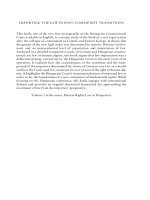Left to right shunt
Bạn đang xem bản rút gọn của tài liệu. Xem và tải ngay bản đầy đủ của tài liệu tại đây (2.37 MB, 88 trang )
William Herring, M.D. © 2003
Left to Right
Shunts
In Slide Show mode, to advance slides, press spacebar
or click left mouse button
What’s the diagnosis?
7 yo acyanotic female
Atrial Septal Defect
Atrial Septal Defect
Four Major Types
●
Ostium secundum
●
Ostium primum
●
Sinus venosus
●
Posteroinferior
Atrial Septal Defect
General
●
●
●
●
4:1 ratio of females to males
Most frequent congenital heart lesion
initially diagnosed in adult
Frequently associated with Ellis-van
Creveld and Holt-Oram syndromes
Associated with prolapsing mitral valve
Holt-Oram Syndrome –
Absence or hypoplasia of the radial ray
Atrial Septal Defect
Ostium Secundum Type
●
●
Most common is ostium secundum
(60%) located at fossa ovalis
High association with prolapse of
mitral valve
Normal
Right atrium open looking into left
atrium through ASD
© Frank Netter, MD Novartis®
Atrial Septal Defect
Ostium Primum Type
●
●
●
Ostium primum type usually part of
endocardial cushion defect
Frequently associated with cleft
mitral and tricuspid valves
Tends to act like VSD physiologically
Looking through
ostium primum defect
at cleft mitral valve
Proximity of ostium
primum defect to
tricuspid valve
© Frank Netter, MD Novartis®
Atrial Septal Defect
Sinus Venosus Type
●
●
Sinus venosus type located high in
inter-atrial septum
90% association of anomalous drainage
of R upper pulmonary vein with SVC
or right atrium
●
Partial anomalous pulmonary venous return
© Frank Netter, MD Novartis®
Right atrium open looking into left atrium through ASD
Atrial Septal Defect
Posteroinferior Type
●
Most rare type
●
Associated with absence of coronary
sinus and left SVC emptying into LA
Atrial Septal Defect
Pulmonary Hypertension
●
Rare in ostium secundum variety (<6%)
■
●
Low pressure shunt from LA ➙ RA
More common in ostium primum variety
■
Behaves physiologically like VSD
37 yo female with severe PAH 2°
ostium primum type of ASD
Atrial Septal Defect
X-Ray Findings
●
Enlarged pulmonary vessels
●
Normal-sized left atrium
●
Normal to small aorta
Prominent
MPA
Prominent
pulmonary
vessels
Normal left
atrium
ASD
Atrial Septal Defect
Complications
●
Large shunts associated with
■
●
●
Pulmonary infections and cardiac arrythmias
Higher incidence of pericardial disease
with ASD than any other CHD
Bacterial endocarditis is rare
Differentiating ASD, PDA and VSD
LA
Ao
ASD
PDA
VSD
Atrial Septal Defect
Why the Left Atrium Isn’t Enlarged
RA
LA
RV
LV
Auckland MRI
Ostium Secundum
ASD
Amersham
Auckland MRI
SCMR
• Discontinuity in the atrial septum with systolic signal void consistent with L->R shunt
on atrial level
• Right atrium is mildly dilated; RV, LV and LA size are normal
What’s the diagnosis?
1 yo acyanotic female
Ventricular Septal
Defect
Ventricular Septal Defect
General
●
●
Most common L ➙ R shunt
Shunt is actually from left ventricle into
pulmonary artery more than into right
ventricle









